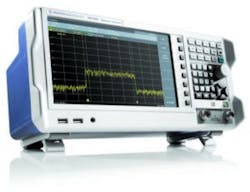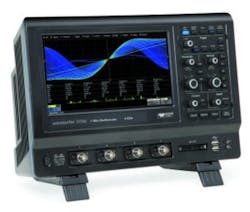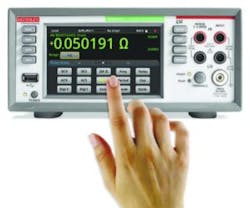Scopes, spectrum analyzers, DMMs highlighted at ESC Boston
Boston, MA. ESC Boston, held April 18-19, provided vendors an opportunity to exhibit recently introduced instruments. Highlights included an entry-level spectrum analyzer that incorporates a 1-port vector network analyzer and a CW signal generator, 100-MHz and 1-GHz versions of an oscilloscope family, and a 6½-digit bench/system digital multimeter plus instrument-control software. In addition, a distributor based in Germany touted an increased presence in the United States.
Rohde & Schwarz noted that it it has extended its R&S FPC spectrum-analyzer family, adding the R&S FPC1500 (Figure 1), which combines a spectrum analyzer, a 1-port vector network analyzer, and a CW signal generator. It is suitable for education, for applications in service and repair shops, and for hobbyists. The company said the R&S FPC1500 is the first spectrum analyzer to include a 1-port vector network analyzer with internal VSWR bridge, an independent CW signal generator, and a tracking generator.
The base model of the R&S FPC1500 has a frequency range of 5 kHz to 1 GHz. Keycode options unlock higher frequency ranges up to 3 GHz or enable other measurement application features. Upgrades are activated immediately when the keycodes are entered, and there is no need for upgrade calibration.
For applications requiring a high sensitivity to characterize extremely weak signals, the R&S FPC1500 offers a low noise floor level of -150 dBm (typ.), which can be further extended to -165 dBm (typ.) through an optional, keycode-activated preamplifier. Users can measure RF signals up to +30 dBm (1 W). In addition, the R&S FPC1500 offers 1-Hz RBW and 10.1-in. (1366×768-pixel) display.
Thanks to the internal VSWR bridge, the R&S FPC1500 can perform reflection measurements, allowing users to measure impedance on antennas or RF circuits, with results displayed on a Smith chart. They can also make distance-to-fault measurements to detect faulty locations on a long RF cable. There is no need to mount and dismount an external VSWR bridge when switching between the spectrum-analyzer and network-analyzer modes.
The tracking generator integrated into the R&S FPC1500 enables scalar transmission measurements on passive and active RF components that do not produce their own RF signal—for example, amplifiers, filters, and even RF cables.
The R&S FPC1500 can also act as an independent continuous-wave (CW) signal generator. Sample applications include using the CW signal source as a local-oscillator signal for mixer measurements or as an input signal for amplifier-gain measurements. Further, the R&S FPC1500 offers a coupled CW mode that couples the generated CW signal to the displayed center frequency of the R&S FPC1500. Whenever a measurement requires a CW signal to follow the R&S FPC1500 center frequency, these operations now can be set in a single step.
Expanded bandwidth for scope series
Teledyne LeCroy highlighted its new WaveSurfer 3000z oscilloscopes (Figure 2), which expand the existing WaveSurfer 3000 bandwidth range above and below that of earlier models while also bolstering functionality for power-electronics testing. In addition, the new models provide more processing power and memory. The WaveSurfer 3000z adds a 100-MHz version as well as a 1-GHz model. The 100-MHz version addresses the requirements of general-purpose debugging and validation tasks, while the 1-GHz model serves users looking for the bandwidth to tackle sophisticated applications such as higher-speed serial communications test and RF signal analysis.
All WaveSurfer 3000z oscilloscopes feature a 10.1-in. capacitive touchscreen, a set of debug and analysis tools, multi-instrument capabilities, feature/option upgrades, and support for a wider probe range. The WaveSurfer 3000z comes in five models with bandwidths from 100 MHz to 1 GHz and sample rates up to 4 GS/s.
The WaveSurfer 3000z combines a new CPU engine, an improved internal-communications bus, and up to 20 Mpoints of acquisition memory, twice that of the WaveSurfer 3000, to facilitate rapid and responsive oscilloscope operation. Meanwhile, the 10.1-in. capacitive touchscreen combines with Teledyne LeCroy’s MAUI user interface to give users a better look at waveforms and deeper insight into signal abnormalities.
Now available for the WaveSurfer 3000z, the Power Analysis software package performs detailed analysis of line power, control loops, and system/device power performance. The WaveSurfer 3000z’s fast display update rate of 130,000 waveforms/s makes it easy to identify anomalies during power analysis.
To augment the Power Analysis software package, the WaveSurfer 3000z offers an active-probe interface that supports Teledyne LeCroy’s power-focused HVFO103 high-voltage, fiber optically-isolated probe, RP4030 power-rail probe, CP03xA high-sensitivity current probes, and HVD3000A high-voltage differential probes.
The WaveSurfer 3000z includes LXI-compatible web browsing to facilitate remote configuration and operation. In the event of AC-line disconnection, a new “power on AC line” feature restores power by simply reattaching the cord. The palette of optional serial trigger/decode packages now adds an Audiobus trigger/decode package, which performs analysis and debug of the digital audio-bus standard in its I2S, LJ, RJ, and TDM variants.
The WaveSurfer 3000z can serve as a 5-in-1 instrument. The function-generator option offers a standard collection of waveforms at up to 25 MHz, while the logic-analyzer option provides 16 digital channels for mixed-signal capabilities. A digital-voltmeter option performs 4-digit voltage measurements and 5-digit
frequency counting on any channel, and the protocol-analyzer option with serial trigger/decode features intuitive, color-coded waveform overlays and interactive data tables.
WaveSurfer 3000z prices range from $3,450 for the 100-MHz 3014z to $9,950 for the 1-GHz 3104z. Serial-data options, including CAN/LIN, CAN FD, I2C/SPI/UART/RS-232, FlexRay, and Audiobus cost $990 each. Multi-instrument options cost $1,500 for mixed-signal hardware/software, $990 for the Power Analysis package, and $500 each for an MSO license and the function-generator option. Bandwidth-upgrade options are available for all WaveSurfer 3000z models.
6½-digit bench/system digital multimeter
Tektronix at ESC Boston highlighted its new Keithley DMM6500 6½-digit bench/system digital multimeter (Figure 3) and DAQ6510 data-acquisition and logging-multimeter system plus KickStart 2.0 instrument-control software. (See p. 12 for more on the DAQ6510 and KickStart 2.0 instrument-control software.) The DMM combines a pinch and zoom touchscreen interface with 15 different measurement functions, wide measurement ranges, and multichannel measurement capability.
Bob Green, senior market-development manager, cited several market trends driving the need for the new instruments, including an increase in low-power IoT and medical devices plus the proliferation of automotive electronics. Consequently, he said, designers need to measure lower currents as battery-operated devices tend to operate with sleep currents of hundreds of nanoamps. In addition, they must capture the complex load currents of wireless devices all while under pressure to get test results quickly.
And on the manufacturing floor, he said, companies are looking to maximize test speed, cut the cost and number of test stations, and reduce the number of instruments in a system—by, for example, employing instruments with wide measurement ranges and more measurement capability. In addition, test systems that supported obsolete products must be kept operational—requiring the replacement of instruments without investing in new software.
To meet these needs, the new 6½-digit multimeter and data-acquisition offerings provide a 5-in. (12.7-cm) touchscreen display with graphing, cursors, and statistics capabilities along with pinch and zoom to offer insight into measurement trends and waveform characteristics, saving time when setting up, monitoring, and executing measurements.
The DMM6500 6½-digit bench/system digital multimeter supports 15 different types of measurements, including capacitance as well as temperature from thermocouples, thermistors, and resistance temperature detectors (RTDs). It can digitize voltage or current waveforms. Waveforms and transients can be captured with the 1-MS/s, 16-bit digitizer so that more measurements can be performed with one instrument and engineers can study more complex load current profiles from wireless devices such as IoT devices.
DC current sensitivity is 10 pA, and resistance sensitivity is 1 µΩ. Accuracy is rated at 0.0025% for one year and includes two-year specifications for longer calibration cycles and lower cost of ownership. Touchscreen cursors make it easy for designers to characterize measurements with statistical data such as peak, average, and minimum values as well as standard deviation over portions of a waveform or over the whole waveform. Up to 7 million readings can be stored in the DMM.
An optional 10-channel scan card or a 9-channel temperature card can be plugged into the rear of the instrument. The DMM6500’s standard interfaces are LAN/LXI and USB-TMC. Optional user-installable interfaces with six programmable digital I/O lines include GPIB, RS-232, and TSP-LINK. To enable test engineers to easily upgrade hardware in legacy test systems with minimal-to-no changes in test code, the DMM6500 has emulation modes for the Keithley Model 2000 6½-digit DMM and the Keysight 34401A 6½-digit DMM. Price for the new DMM starts at $1,140.
From VNAs to components
Other vendors were on hand at ESC Boston as well. Pico Technology exhibited its lineup of USB oscilloscopes, but a particular highlight was the PicoVNA 106, a USB-controlled full-function bidirectional vector network analyzer covering 300 kHz to 6 GHz. The company has cited several applications for VNAs, including dielectric measurements, penetrating radar, and imaging, be it ground, tissues, foods, or engineering materials. RIGOL highlighted its instrument lineup, including oscilloscopes as well as the RSA5000 real-time spectrum analyzer. Of particular interest at the show were RIGOL’s solutions for EMC precompliance test and debug. Siglent exhibited its lineup of digital oscilloscopes, waveform generators, power supplies, and DMMs, and it previewed a new vector network analyzer, with details to be released soon. And Ironwood Electronics highlighted its high-performance sockets and adapters, including PLCC adapters that snap onto the PLCC package or insert into a PLCC socket, providing reliable access and interconnection to all signals.
And finally, Rutronik Inc., a global broad-line stocking distributor with a comprehensive portfolio of electronic components, touted the opening of two new offices as part of an ongoing sales network expansion in North America. “In order to better support our growing customer base in North America, we’ve opened sales offices near Boston and Silicon Valley,” said Sean Sisson, Rutronik vice president North America, in a press release issued before the show. “Staffed with field application engineers and sales specialists, these offices complement our sales network, including our Texas-based headquarters and warehouse operations in North America.”
He continued, “As inventories continue to tighten across a range of components, we’re positioning Rutronik to work closely with our customers in these key markets to provide sales support, technical assistance, and on-time deliveries.”
An established global distributor based in Germany with annual sales of $1.5 billion, Rutronik has been expanding its presence in the North American market with a range of electronic components and services, including semiconductors and passive and electromechanical components as well as embedded boards, storage technologies, displays, and wireless products. EE



